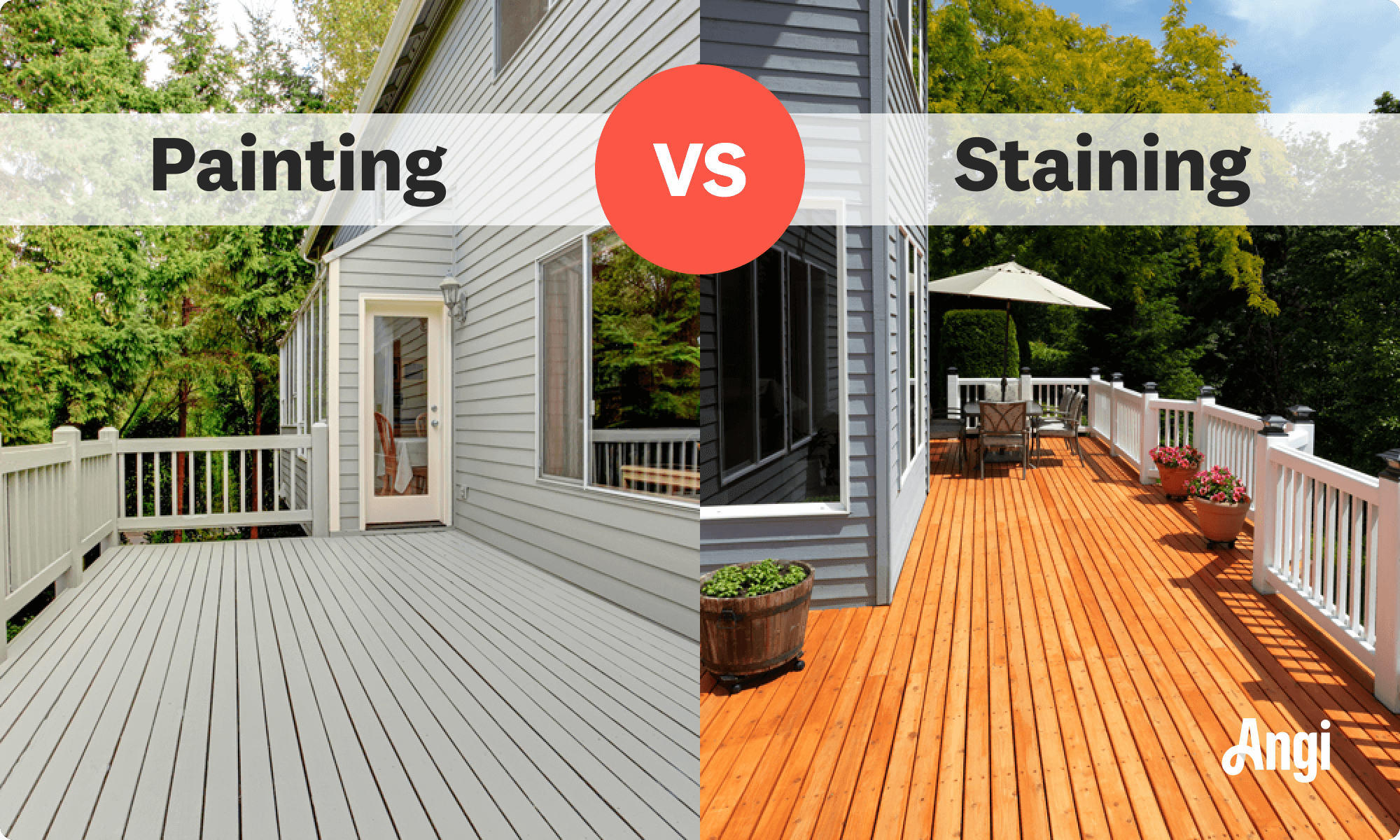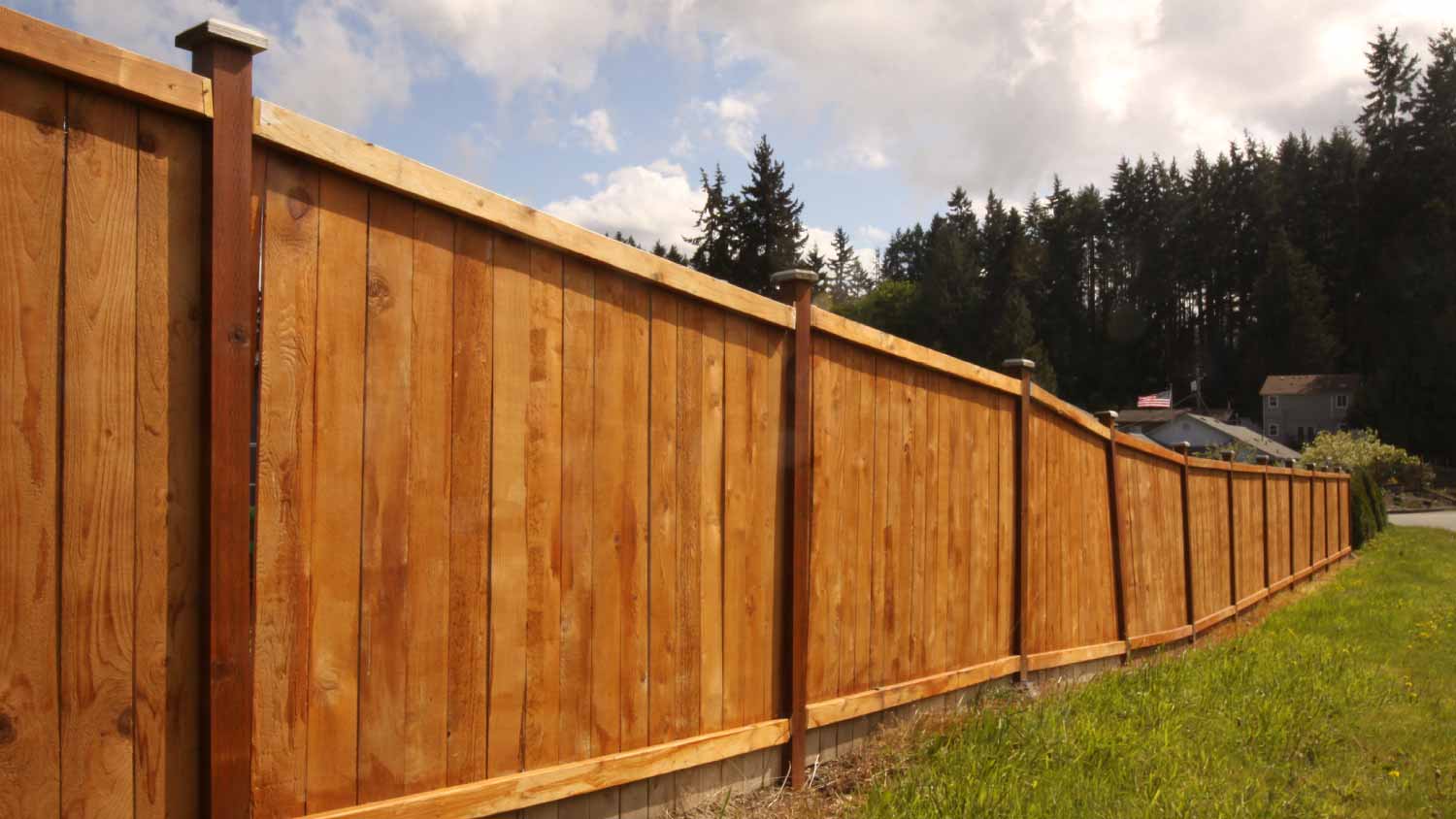
The cost to stain a deck varies depending on its size, location, and type of stain. Keep reading to learn more about how much you might spend.
Fresh paint or stain can make your deck the envy of the neighborhood


Staining a deck costs $850, while painting a deck costs $1,000.
Paint lasts up to a decade, while stain lasts two to three years.
Stain shows off the natural wood grain, while paint offers more color options.
Stain is easier to apply than paint as a DIY project.
One of the best parts about summer nights is spending time relaxing on your deck. It’s easier to relax when your wood deck is in top condition, meaning you may need to paint or stain your deck every few years. Choosing to apply paint versus stain on a deck depends on the benefits you’re seeking. Learn more about how to keep your deck looking great with paint or stain while protecting it from the elements.

Choosing to apply paint versus stain on a deck depends on what you’d like to accomplish and the condition of the deck. Painting a deck yields a modern appearance with any color you like. It can also hide flaws in the wood. Staining a deck creates a more natural look, highlighting the grain of the wood, while carrying a lower application cost.
Painting a deck involves applying a coat of paint over the wood of the deck. Because most wood decks consist of pressure-treated wood, you’ll need to use a primer over the wood first. You’ll probably then need two coats of colored paint over the primer.
| Pros | Cons |
|---|---|
| It lasts a long time | Higher cost to apply |
| Protects from UV light | Tough to remove later |
| Multiple color options | Need specific paint |
Best for:
Those who want a specific color on the deck
Those with rough wood surfaces
Hiding the greenish tint in treated wood
Should I paint my deck? Painting a deck is a good option for people who want a certain color. If you have rough wood on the deck and don’t want to sand it, paint can cover some of the imperfections. Paint can also cover the greenish tint that pressure-treated wood often has.
A coat of paint is a good way to protect the wood from UV light and excess moisture. When you apply a coat of paint, you’ll potentially receive up to 10 years of protection before having to reapply it.
Applying paint is more labor intensive than stain, meaning you’ll spend more money to hire a professional to do the job. If your deck consists of pressure-treated wood, the best exterior paint for this job is latex paint, rather than oil-based paint, limiting your paint choices.
If you choose to paint the deck, it’s much more difficult to switch back to stain later. Fully removing the paint from the deck can be a challenge. It’s easier to go from stain to paint than vice versa.
Staining a deck involves coating the wood with a wood stain. Staining gives the wood a natural color while allowing the wood grain to remain visible. A sealant can protect the wood from excess moisture, preventing rot in the future.
| Pros | Cons |
|---|---|
| Easy to apply to a deck | Fades fast in sunlight |
| May only need one coat | Must reapply more often |
| Costs less than paint | May need to sand first |
Best for:
Those who want the natural wood grain to show through
Those who don’t mind sanding the wood
Decks that have less direct sun exposure
Should I stain my deck? Staining is a popular choice if you want the natural wood grain to show through and give your deck a more rustic look.
Staining can be an easier process than painting. It often only requires one coat, making it less labor-intensive than paint. Hiring a pro to stain the deck also costs less than having a pro paint it.
If the deck's surface is rough, which is common for pressure-treated wood, you will need to sand it before staining. Stain does not hide imperfections as efficiently as paint does.
For decks exposed to direct sun, stain will fade faster than paint. You may need to reapply the stain every two to three years. If you want UV protection for your stained wood deck, you’d need to select a solid or semi-transparent stain.
Deciding whether to paint or stain a deck ultimately depends on your preferences in a few different categories. Learn more about the comparisons of deck paint versus stain in key categories.
Whether you like the look of paint or stain on a deck is a personal preference. However, the appearance of stain is highly popular. Stain lets the grain of the wood remain visible, while paint hides it.
Stain delivers a natural, rustic look to the deck. Paint creates a modern, sleek look for the space.
When you stain the deck, you can select from a few different shades. However, for a customized look that’s different from anything else in the neighborhood, painting is the better choice because it offers far more color options.
You could match the color of the house or trim pieces, or you could even create a custom pattern. However, stain is primarily available only in shades of brown, red, or gray.
Paint creates a thicker protective layer over the wood than stain, giving it better durability. A coat of paint lasts longer than stain and provides better protection against UV light. If you have a grill on the deck, paint will protect the wood from dripping grease better than stain.
Staining the deck is a little more budget-friendly than painting it. For staining, you can hire a local deck staining company. The cost to professionally stain a deck averages about $850.
You can also hire a local deck painting professional to paint your deck. The local pro will know the correct type of paint to use, ensuring the paint lasts longer. The cost to paint a deck averages about $1,000.
If you also need your house painted, some painters might give you a price break to paint more than one structure on the same job. The cost to paint a house averages about $3,200 alone.
You could try to paint or stain the deck yourself to save some money. It’s a little easier to stain the deck than to paint it because you’ll likely have to use more than one coat of paint.
However, if you must sand the deck before staining, the job becomes more labor-intensive. Paint can cover some roughness or flaws in the deck's wood, but stain cannot.
You will need to reapply both paint and stain several times over the life of the wood deck. You’ll also need to clean the deck with a pressure wash every so often, regardless of whether it’s painted or stained.
When you paint your deck—and if you use or a professional selects the right paint and applies it correctly—it could last as long as 10 years before it needs repainting. However, you’ll need to reapply stain every two or three years.
Paint stands up to UV light from sun exposure without fading much better than stain.
From average costs to expert advice, get all the answers you need to get your job done.

The cost to stain a deck varies depending on its size, location, and type of stain. Keep reading to learn more about how much you might spend.

Painting a garage door is one of the most impactful projects you can undertake with a smaller budget. Learn what makes up the total cost, as well as tips on how you can save.

The cost of materials and labor all factor into your overall brick staining cost, but what other factors impact the bottom line? Our guide covers this and more.

Can you paint pressure-treated wood? Learn why painting pressure-treated wood is a good way to extend the lifespan of the material.

Whether you opt for low-luster or high-gloss depends on budget, skill, aesthetics, and material. Learn how to pick the best sheen for exterior paint projects.

Planning to stain a fence? You’re likely wondering: How much stain do I need for my fence? Figure it out with our fence stain calculator.